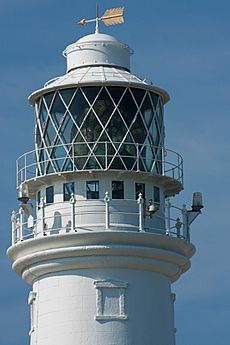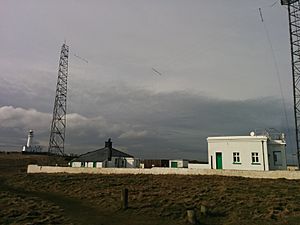Flamborough Head Lighthouse facts for kids
| Location | Flamborough East Riding of Yorkshire England |
|---|---|
| Tower shape | cylindrical tower with double balcony and lantern |
| Original lens | first order Fresnel lens
(until 2022 were replaced by LED lantern lens since removed and on display as of 2022) |
| Fog signal | 1 blast every 90s. (formerly 2 blasts every 90s until 2022) |
The Flamborough Head Lighthouse is an important lighthouse located at Flamborough, in East Riding of Yorkshire, England. It helps guide ships safely along the coast. The lighthouse acts like a signpost for large ships and smaller boats. It helps them find their way past Flamborough Head and towards towns like Scarborough and Bridlington.
Contents
The First Lighthouse
The very first lighthouse at Flamborough was built a long time ago, in 1674. It was built by a person named Sir John Clayton. This old lighthouse is one of the oldest complete lighthouses still standing in England. It was made from chalk, but it was never actually lit up to guide ships. Today, it is a special historic building.
The Current Lighthouse
The lighthouse you see today was designed by Samuel Wyatt. It cost about £8,000 to build. The light was first turned on more than 200 years ago, on December 1, 1806.
How the Light Worked
This lighthouse had a special way of flashing its light. It would show two white flashes, then one red flash. This unique pattern helped sailors know it was Flamborough Head Lighthouse.
The special light was created by George Robinson. He designed a spinning frame with 21 lamps. Seven lamps were on each side. On one side, the lamps had red glass covers. This was the first time red glass was used in a lighthouse! It helped ships tell this lighthouse apart from others, like the one at Cromer. Sailors even had a saying to remember it: "Two whites to one red / Indicates Flambro' Head."
Changes Over Time
In 1872, the lighthouse got a new lamp that used paraffin, a type of oil. Flamborough was the first lighthouse run by Trinity House (the group that manages lighthouses in England) to use paraffin.
Along with the new lamp, a large, special lens was added. This lens was called a first-order Fresnel lens and was made by Chance Brothers. It kept the same two white, one red flash pattern. The light started spinning faster, giving a flash every 30 seconds instead of every two minutes. This made the light visible from about 21 nautical miles away. In 1907, the light spun even faster, flashing every 15 seconds.
In 1925, the top part of the lighthouse, called the lantern, was made taller. This was to fit an even bigger lens. This new lens showed four white flashes every 15 seconds. The old lens was later sent to the Bahamas to be used in their lighthouses. In 1940, the light was changed from oil to electricity.
Modern Lighthouse Operations
The lighthouse became automated in 1996. This means machines took over, and lighthouse keepers were no longer needed to live there. The last keepers left on May 8, 1996. The lighthouse is still working today and is also a historic building.
In 2022, the lighthouse was updated again. The old spinning lens was removed. It was replaced with two modern, static LED lights. These new lights can be seen from about 18 nautical miles away.
Sometimes, you can visit the lighthouse! The old lens that was removed in 2022 is now on display at the visitor center nearby.
Fog Signal Station
A fog signal station was built in 1859, a little distance from the lighthouse. This station helps ships when it's foggy and they can't see the light.
At first, they used an 18-pound gun to make a loud sound every 15 minutes. A small house was built for the people who fired the gun. In 1878, they started using explosive rockets instead of the gun. These rockets went up 600 feet into the air and were fired every 10 minutes when it was foggy.
In 1908, an engine house was built, and a loud siren replaced the rockets. It made one long and one short blast every 90 seconds. This sound came from large trumpets on the roof.
Later, in 1924, the siren was replaced by different sound devices called diaphones. These were put in a metal tower on the engine house. In 1975, an electric fog signal took over. In 2022, the signal was changed to just one long blast every 90 seconds.
The fog signal area is still owned by Trinity House. Besides the modern fog signal, it also has a special system called DGPS that helps ships know their exact location.
See also
 In Spanish: Faro de Cabo Flamborough para niños
In Spanish: Faro de Cabo Flamborough para niños
- List of lighthouses in England




